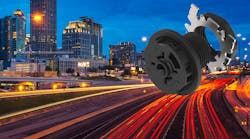As more and more devices become connected to the Industrial Internet of Things (IIoT), increased strain is placed on the network to quickly and accurately transmit data. A responsive network is essential for the development of smart cities, which are built upon the importance of component connectivity. How, then, can the current network meet the demands of IIoT?
Enter 5G.
In comparison to the 4G network, 5G offers faster data transmission and the ability to connect more devices at once. Essentially, 5G enables IIoT by supporting billions of device connections into the same ecosystem. Fostering ultra-reliable machine communication and reducing data transmission latency is imperative for creating smart city infrastructure. Applications need real-time data to make informed decisions.
Cities Made Smarter
What if you were able to know exactly where parking spots were open in a crowded downtown city? How about if trash cans were able to sense when they were full and alert city management? Can you imagine a streetlight as an electric vehicle charging station? There is one thing all of these future-state applications have in common—they will need to be supported by a 5G, IIoT network.
By 2025, it is estimated that around 75 billion devices will be connected to the same cloud. This means the Internet ecosystem must advance quickly to support such a high amount of connection demand. Because 5G enhances the quality and speed of data transmission, the hyper-connected needs of the future can be met.
The benefits of enabling smarter cities are immense. In a world filled with climate challenges, smart cities present a solution to conserving energy and increasing efficiency with controls. Additional benefits of smart cities include shorter commute times, reduced crime and improved overall quality of life.
However, integrating smart applications into cities is no small task. From privacy concerns to developing solutions built to withstand harsh environments, smart city design represents an engineering challenge. However, with the help of 5G, adoption of smart applications is on the rise. One challenge that customers face is how to integrate a complex 5G network within existing infrastructures.
Two-Node Streetlight Architecture
Rather than scrapping the existing network and building from scratch, customers can instead source components that allow them to add 5G functionality while still using the same systems. For example, LUMAWISE connectors from TE Connectivity integrate into outdoor lighting luminaires and motion sensor modules. The product line is designed for harsh outdoor environments and enhances control features needed for smart city design.
Currently, streetlights are powered and controlled by a single-node architecture design. Traditional streetlights use either an ANSI C136 standard connection or a Zhaga Book 18 standard interface to connect control modules to the luminaire, which allows for basic operations such as turning the light on and off.
However, moving to two-node architecture opens up new possibilities for energy savings and increased safety with IIoT data gathered via a 5G network. Two-node architecture provides more connectivity, more communication and, as a result, more data than traditional one-node architecture. A hybrid structure allows for a plethora of increased functionality and applications starting with motion detection.
Connected to a 5G, IIoT network, motion sensor dimming technology can reduce the amount of voltage used to power a streetlight, depending on environmental context. If little motion is detected, a light might only operate at around 20% capacity. However, if high amounts of motion are detected, the light will power to 100%. This saves money while reducing light pollution and stray light glare. Motion sensors can also monitor vehicle, bicycle and pedestrian traffic, providing valuable, real-time information to cities around population count and movement.
Two-node architecture also enhances safety. Rising rates of urbanization drive the ability and demand for outdoor monitoring applications. Cameras and streetlight motion sensors provide outdoor surveillance capabilities that have the potential to greatly improve quality of life in urban areas.
For example, perhaps there is an area where crime is particularly high—with two-node architecture, cities can choose to keep lights fully powered in these areas to increase safety at night. Alternatively, maybe there are areas where crime rates are low—cities can choose to dim lights and save energy in these areas.
Because of 5G, decisions surrounding emergency responses can be made in real-time with fast and secure data transmission. This is the primary difference between smart surveillance and current monitoring technology—data input can be gathered and analyzed in real-time from streetlights and cameras to proactively prevent accidents from happening, rather than just knowing they happen.
Smart surveillance has the ability to save lives by allowing for faster emergency response times and preventing crime from occurring. Additionally, smart surveillance technology can monitor pollution and energy usage, steering cities in a safer, greener direction.
As automation and controls only increase, smart cities and smart lighting technology will continue to rise in importance. With the implementation of 5G and the hyper-connected capabilities of IIoT, safer and sustainable urban growth can be achieved.
Leigh Marolf is director of business development and strategy at TE Connectivity.
